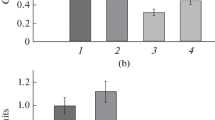Abstract
The potential mechanisms underlying the increase in serum iron concentration in gamma-irradiated mice were studied. The gamma irradiation dose used was 4 Gy, and cobalt-60 (60Co) source was used for the irradiation. The dose rate was 0.25 Gy/min. In the serum of irradiated mice, the concentration of ferrous ions decreased, whereas the serum iron concentration increased. The concentration of ferrous ions in irradiated mice returned to normal at 21 day post-exposure. The concentration of reactive oxygen species in irradiated mice increased immediately following irradiation but returned to normal at 7 day post-exposure. Serum iron concentration in gamma-irradiated mice that were pretreated with reduced glutathione was significant lower (p < 0.01) than that in mice exposed to gamma radiation only. However, the serum iron concentration was still higher than that in normal mice (p < 0.01). This change was biphasic, characterized by a maximal decrease phase occurring immediately after gamma irradiation (relative to the irradiated mice) and a recovery plateau observed during the 7th and 21st day post-irradiation, but serum iron recovery was still less than that in the gamma-irradiated mice (4 Gy). In gamma-irradiated mice, ceruloplasmin activity increased and serum copper concentration decreased immediately after irradiation, and both of them were constant during the 7th and 21st day post-irradiation. It was concluded that ferrous ions in irradiated mice were oxidized to ferric ions by ionizing radiation. Free radicals induced by gamma radiation and ceruloplasmin mutually participated in this oxidation process. The ferroxidase effect of ceruloplasmin was achieved by transfer of electrons from ferrous ions to cupric ions.





Similar content being viewed by others
References
Abdou MI, Shaban HA, EI Gohary MI (2010) Changes in serum zinc, copper and ceruloplasmin levels of whole body gamma irradiated rats. In: Tenth radiation physics and protection. Proceedings of National Network of Radiation Physics conference. National Network of Radiation Physics, Cario, pp 1–26
Aladjov E, Vlaykova T (1997) Changes in serum ceruloplasmin activity after whole body irradiation of mammals. J Radiat Res 38:157–163
Anbumani S, Mohankumar MN (2012) Gamma radiation induced micronuclei and erythrocyte cellular abnormalities in the fish Catla catla. Aquat Toxicol 122:125–132
Andrews NC (1999) The iron transporter DMT1. Int J Biochem Cell Biol 31:991–994
Barjaktarovic Z, Schmaltz D, Shyla A, Azimzadeh O, Schulz S, Haagen J et al (2011) Radiation-induced signaling results in mitochondrial impairment in mouse heart at 4 weeks after exposure to X-rays. PLoS One 6:e27811
Bo S, Durazzo M, Gambino R, Berutti C, Milanesio N, Caropreso A et al (2008) Associations of dietary and serum copper with inflammation, oxidative stress, and metabolic variables in adults. J Nutr 138:305–310
Bothwell TH, Charlton RW, Cook JD, Finch CA (1979) Iron metabolism in man. Blackwell Scientific, Oxford, pp 971–999
Budagov RS, Ashurov AA, Zaĭchik VE (1994) Blood trace elements as an indicator of the degree of severity in radiation lesions. Radiat Biol Radioecol 34:49–54
Ganz T (2003) Hepcidin, a key regulation of iron metabolism and mediator of anemia of inflammation. Blood 102(783–788):2003
Goldstein IM, Kaplan HB, Edelson HS et al (1979) Ceruloplasmin: a scavenger of superoxide anion radicals. J Biol Chem 254:4040–4045
Gray NK, Pantopoulos K, Dandekar T, Ackrell BAC, Hentze MW (1996) Translational regulation of mammalian and Drosophila citric acid cycle enzymes via iron-responsive elements. Proc Natl Acad Sci 93:4925–4930
Hinzmann R (2003) Iron metabolism, iron deficiency and anaemia from diagnosis to treatment and monitoring. Sysmex J Int 13:65–74
Houben JL (1971) Free radicals produced by ionizing radiation in bone and its constituents. Int J Radiat Biol 20:373–389
Ma J, Haldar S, Khan MA, Sharma SD, Merrick WC, Theil EC, Goss DJ (2012) Fe2+ binds iron responsive element-RNA, selectively changing protein-binding affinities and regulating mRNA repression and activation. Proc Natl Acad Sci 109:8417–8422
McKie AT, Barrow D, Go Latunde-Dada et al (2001) An iron-regulated ferric reductase associated with the absorption of dietary iron. Science 291:1755–1759
Ponka P (1997) Tissue-specific regulation of iron metabolism and heme synthesis: distinct control mechanisms in erythroid cells. Blood 89:1–25
Protasova OV, Maksimova IA, Cheprasov VY, Nikiforov AM (2001) Altered balance of macroelements and trace elements in blood serum, its ultrafiltrates, and hairs long after exposure to low doses of ionizing radiation. Biol Bull 28:344–349
Pulatova MK, Sharygin VL, Shlyakova TG, Sipyagina AE, Wasserman AM (2009) Use of EPR spectroscopy to check the changes in organism radioresistance. Clin results. Biophys 54:223–231
Ray S, Chatterjee A (2007) Influence of glutathione on the induction of chromosome aberrations, delay in cell cycle kinetics and cell cycle regulator proteins in irradiated mouse bone marrow cells. Int J Radiat Biol 83:347–354
Slater TF (1987) Free radicals and tissue injury: fact and fiction. Br J Cancer 8:5–10
Szweda-Lewandowska Z, Puchala M, Leyko W (1976) Effects of gamma irradiation on the structure and function of human hemoglobin. Radiat Res 65:50–59
United States Nuclear Regulatory Commission (2011) Fact sheet on biological effects of radiation. USNRC Technical Training Center 9-1.0603, USNRC, Washington, DC
Wang J, Pantopoulos K (2011) Regulation of cellular iron metabolism. Biochem J 434:365–381
Wu MJ, Zhan JW, Jiang CH (2006) Radiological lesions and trace elements. Stud Trace Elem Health 23:51–52
Xu XF, Zhao FL, Wang S et al (2008) Quantitative measurement of Fe(II) in human blood with spectral analysis method. Spectrosc Spectr Anal 28:2927–2930
Zgirski A, Gasyna Z, Hilewicz-Grabska M (1980) Primary electron-accepting sites and electron transport reaction in human ceruloplasmin: low-temperature radiolysis study. FEBS Lett 113:149–152
Zhang XH, Lou ZC, Wang AL, Hu XD, Zhang HQ (2013a) Development of serum iron for biological dosimetry in mice. Radiat Res 179:684–689
Zhang XH, Min XY, Wang AL et al (2013b) Development of a serum copper-based biological dosimetry in whole body gamma irradiation of mice. Health Phys 105:351–355
Acknowledgments
This work was supported by the NUAA Fundamental Research Funds (No. NS2014055).
Author information
Authors and Affiliations
Corresponding author
Rights and permissions
About this article
Cite this article
Xie, Lh., Zhang, Xh., Hu, Xd. et al. Mechanisms of an increased level of serum iron in gamma-irradiated mice. Radiat Environ Biophys 55, 81–88 (2016). https://doi.org/10.1007/s00411-015-0623-4
Received:
Accepted:
Published:
Issue Date:
DOI: https://doi.org/10.1007/s00411-015-0623-4



